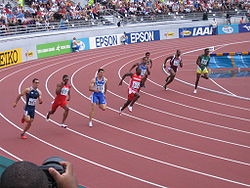Difference between revisions of "AY Honors/Track & Field/Answer Key"
From Pathfinder Wiki
< AY Honors | Track & FieldAY Honors/Track & Field/Answer Key
| Line 8: | Line 8: | ||
===500 m=== | ===500 m=== | ||
*More common than 300 m and 150 m, because this is half a kilometre. This could aid 400 m runners in their stamina, or help a middle-distance runner to gain speed. The borderline distance between sprints and middle distance. This is usually run indoor by high school athletes and on occasion collegiate athletes. | *More common than 300 m and 150 m, because this is half a kilometre. This could aid 400 m runners in their stamina, or help a middle-distance runner to gain speed. The borderline distance between sprints and middle distance. This is usually run indoor by high school athletes and on occasion collegiate athletes. | ||
| − | |||
| − | |||
| − | |||
===Biological factors for runners=== | ===Biological factors for runners=== | ||
Revision as of 00:09, 17 March 2009
Template:Original research Template:Expert
Sprints are short running races in athletics. They are roughly classified as events in which top runners will not have to "pace themselves", but can run as fast as possible for the entire distance.
Common distances
Uncommon distances
500 m
- More common than 300 m and 150 m, because this is half a kilometre. This could aid 400 m runners in their stamina, or help a middle-distance runner to gain speed. The borderline distance between sprints and middle distance. This is usually run indoor by high school athletes and on occasion collegiate athletes.
Biological factors for runners
Some biological factors that determine a sprinter's potential are:
- Muscular strength
- Adrenaline use
- Anaerobic respiration capacity
- Breathing
- Proportion of fast twitch muscles&
Other sports
- The most common distance for rowing races is 2 kilometres. Races may be held at less than 1 km, which are known as dashes.
- Horse Racing and Hamster racing have sprint distance events.
- Track cycling features a sprint event, in which usually two riders compete over a distance of 1000 metres, though only the final 200 m may be timed. However, the time is normally immaterial - the aim is to be first across the line and win two races in a 'best of three races' match.
- The term sprinting can be applied in any racing sport, such as swimming.
- A 90 m beach sprint is held in surf lifesaving carnivals in Australia.
- Sprint car racing is a type of auto racing held in short ovals. In motorcycle racing and other auto racing disciplines, the term sprint race is used to describe a short race, for example one that lasts under 30 minutes.
See also
- World record progression 100 metres men
- World Record progression 100 m women
- National champions 100 metres (men)
- 100 yard dash
- Athletics (track and field)
- Athletics long distances
- Athletics middle distances
- Footspeed
- List of sprinters
- Relay race
- Motorsport
References
- ↑ Quinn, Elizabeth (2007-10-30). Fast and Slow Twitch Muscle Fibers About.com. Retrieved on 2009-02-01.
External links
bg:Спринт ca:Carrera de velocitat cs:Sprint da:Sprint de:Sprint es:Carreras de velocidad eo:Kurtadistanca kuro fr:Sprint (athlétisme) it:Velocità (atletica) ja:短距離走 ka:სპრინტი lt:Sprintas nl:Sprint (atletiek) no:Sprintløp pt:Corrida ru:Спринт sq:Sprint simple:Sprint sl:Šprint sv:Kortdistanslöpning ta:விரைவோட்டம் tr:Sprint zh:短跑

